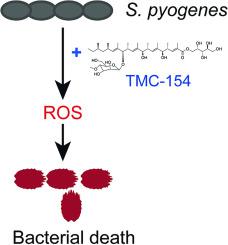当前位置:
X-MOL 学术
›
J. Proteomics
›
论文详情
Our official English website, www.x-mol.net, welcomes your
feedback! (Note: you will need to create a separate account there.)
The erythromycin polyketide compound TMC-154 stimulates ROS generation to exert antibacterial effects against Streptococcus pyogenes
Journal of Proteomics ( IF 2.8 ) Pub Date : 2023-12-01 , DOI: 10.1016/j.jprot.2023.105057 Yuan-Feng Yan 1 , Ying Liu 1 , Hangeri Liang 1 , Le Cai 2 , Xiao-Yan Yang 1 , Tian-Peng Yin 1
Journal of Proteomics ( IF 2.8 ) Pub Date : 2023-12-01 , DOI: 10.1016/j.jprot.2023.105057 Yuan-Feng Yan 1 , Ying Liu 1 , Hangeri Liang 1 , Le Cai 2 , Xiao-Yan Yang 1 , Tian-Peng Yin 1
Affiliation

|
The erythromycin polyketide compound TMC-154 is a secondary metabolite that is isolated from the rhizospheric fungus associated with , which possesses antibacterial activity. However, its antibacterial mechanism has not been investigated thus far. In this study, proteomics coupled with bioinformatics approaches was used to explore the antibacterial mechanism of TMC-154. KEGG pathway enrichment analysis indicated that eight signaling pathways were associated with TMC-154, including oxidative phosphorylation, cationic antimicrobial peptide (CAMP) resistance, benzoate degradation, heme acquisition systems, glycine/serine and threonine metabolism, beta-lactam resistance, ascorbate and aldarate metabolism, and phosphotransferase system (PTS). Cell biology experiments confirmed that TMC-154 could induce reactive oxygen species (ROS) generation in ; moreover, TMC-154-induced antibacterial effects could be blocked by the inhibition of ROS generation with the antioxidant -acetyl L-cysteine. In addition, TMC-154 combined with ciprofloxacin or chloramphenicol had synergistic antibacterial effects. These findings indicate the potential of TMC-154 as a promising drug to treat infections. is a nearly ubiquitous human pathogen that causes a variety of diseases ranging from mild pharyngitis and skin infection to fatal sepsis and toxic heat shock syndrome. With the increasing incidence of known antibiotic resistance, there is an urgent need to find novel drugs with good antibacterial activity against . In this study, we found that TMC-154, a secondary metabolite from the fungus , inhibited the growth of various bacteria, including , , , and . Proteomic analysis combined with cell biology experiments revealed that TMC-154 stimulated ROS generation to exert antibacterial effects against . This study provides potential options for the treatment of infections in the future.
中文翻译:

红霉素聚酮化合物TMC-154刺激ROS产生,对化脓性链球菌发挥抗菌作用
红霉素聚酮化合物TMC-154是从与红霉素相关的根际真菌中分离出来的次级代谢产物,具有抗菌活性。但其抗菌机制至今尚未被研究。本研究采用蛋白质组学结合生物信息学方法探讨TMC-154的抗菌机制。 KEGG通路富集分析表明,8个信号通路与TMC-154相关,包括氧化磷酸化、阳离子抗菌肽(CAMP)耐药、苯甲酸降解、血红素获取系统、甘氨酸/丝氨酸和苏氨酸代谢、β-内酰胺耐药、抗坏血酸和醛糖酸代谢和磷酸转移酶系统(PTS)。细胞生物学实验证实,TMC-154 可以诱导活性氧 (ROS) 的产生;此外,TMC-154诱导的抗菌作用可以通过抗氧化剂-乙酰L-半胱氨酸抑制ROS的产生来阻断。此外,TMC-154与环丙沙星或氯霉素联用具有协同抗菌作用。这些发现表明 TMC-154 作为治疗感染的有前景药物的潜力。是一种几乎无处不在的人类病原体,可引起多种疾病,从轻微的咽炎和皮肤感染到致命的败血症和中毒性热休克综合症。随着已知抗生素耐药性发生率的不断增加,迫切需要寻找具有良好抗菌活性的新型药物。在这项研究中,我们发现 TMC-154(真菌的次级代谢产物)可抑制多种细菌的生长,包括 、 、 和 。蛋白质组分析结合细胞生物学实验表明,TMC-154 刺激 ROS 产生,对 . 这项研究为未来治疗感染提供了潜在的选择。
更新日期:2023-12-01
中文翻译:

红霉素聚酮化合物TMC-154刺激ROS产生,对化脓性链球菌发挥抗菌作用
红霉素聚酮化合物TMC-154是从与红霉素相关的根际真菌中分离出来的次级代谢产物,具有抗菌活性。但其抗菌机制至今尚未被研究。本研究采用蛋白质组学结合生物信息学方法探讨TMC-154的抗菌机制。 KEGG通路富集分析表明,8个信号通路与TMC-154相关,包括氧化磷酸化、阳离子抗菌肽(CAMP)耐药、苯甲酸降解、血红素获取系统、甘氨酸/丝氨酸和苏氨酸代谢、β-内酰胺耐药、抗坏血酸和醛糖酸代谢和磷酸转移酶系统(PTS)。细胞生物学实验证实,TMC-154 可以诱导活性氧 (ROS) 的产生;此外,TMC-154诱导的抗菌作用可以通过抗氧化剂-乙酰L-半胱氨酸抑制ROS的产生来阻断。此外,TMC-154与环丙沙星或氯霉素联用具有协同抗菌作用。这些发现表明 TMC-154 作为治疗感染的有前景药物的潜力。是一种几乎无处不在的人类病原体,可引起多种疾病,从轻微的咽炎和皮肤感染到致命的败血症和中毒性热休克综合症。随着已知抗生素耐药性发生率的不断增加,迫切需要寻找具有良好抗菌活性的新型药物。在这项研究中,我们发现 TMC-154(真菌的次级代谢产物)可抑制多种细菌的生长,包括 、 、 和 。蛋白质组分析结合细胞生物学实验表明,TMC-154 刺激 ROS 产生,对 . 这项研究为未来治疗感染提供了潜在的选择。


















































 京公网安备 11010802027423号
京公网安备 11010802027423号